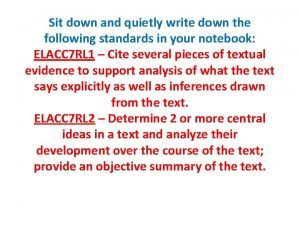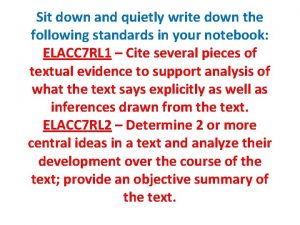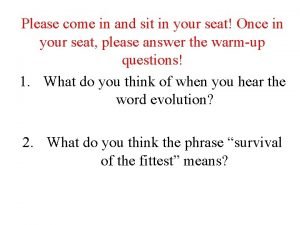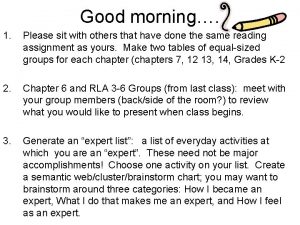GOOD MORNING Please sit down quietly Take out





















- Slides: 21

GOOD MORNING!! • Please sit down quietly • Take out a piece of paper 25 • Yes we are taking notes but it won’t take long • Then you are doing a vocab chart thing • Then you are done

Chapter 12: Psychological Disorders MODULE 27: INTRODUCTION TO PSYCHOLOGICAL DISORDERS

What do you think? • Page 518 • Do you think that these are disorders… or just abnormal?

• Psychological Disorder Defining Disorder – A “harmful dysfunction” associated with distress or impairment and a reaction that isn’t culturally expected…behaviors are maladaptive, unjustifiable, disturbing, and atypical

MUDA • A mnemonic device used to remember the four attributes of a psychological disorder – Maladaptive – Unjustifiable – Disturbing – Atypical

Maladaptive • An exaggeration of normal, acceptable behaviors • Destructive to oneself or others Unjustifiable • A behavior which does not have a rational basis

Disturbing • A behavior which is troublesome to other people Atypical • A behavior so different from other people’s behavior that it violates a norm • Norms vary from culture to culture

Module 27: Introduction to Psychological Disorders UNDERSTANDING DISORDERS

GOOD MORNING!! • Sit in your assigned seat • Take out your notes from yesterday (bookwork) • We are going to finish going over the “Intro to Psych Disorders” • Then do notes on Anxiety Disorders • Then watch a video

Early Views of Mental Illness • In ancient times, mental illness was usually explained through a supernatural model; the person was possessed or a sinner • During the Middle Ages treatment https: //www. youtube. com/watch? v=y. Qa_sg 4 z. N 88 methods were inhumane and cruel

Philippe Pinel (1745 -1826) • French physician who worked to reform the treatment of people with mental disorders • Encouraged more humane treatment – No more electro-shock therapy or torture

Module 27: Introduction to Psychological Disorders UNDERSTANDING DISORDERS: THE MEDICAL MODEL

The Medical Model • Abnormal behavior is the result of physical problems and can be treated medically • Diseases have physical causes that can be diagnosed, treated, and in most cases, cured. (Like a broken arm) • Psychological disorders are similar to a physical illness.

Module 27: Introduction to Psychological Disorders UNDERSTANDING DISORDERS: THE BIO-PSYCHOSOCIAL MODEL

Bio-Psycho-Social Model • Perspective of mental illness which assumes that biological, psychological, and socio-cultural factors combine and interact to produce psychological disorders…any one factor is not sufficient.

Bio-Psycho-Social Perspective

Module 27: Introduction to Psychological Disorders CLASSIFYING DISORDERS

Classifying Disorders: DSM 5 • Diagnostic and Statistical Manual of Mental Disorders – Fifth Addition • Published by the American Psychiatric Association • Lists and describes all the currently accepted categories of mental disorders

DSM 5 • Divides mental disorders into 18 major categories • Includes the symptoms but not the causes of each disease • Has changed significantly since the first edition

Module 27: Introduction to Psychological Disorders LABELING DISORDERS

Labeling Stigmas • Studies show a clear bias against people diagnosed with mental disorders.
 Sit down quietly
Sit down quietly Sit down quietly
Sit down quietly Cómo se dice buenas tardes
Cómo se dice buenas tardes Good morning class
Good morning class Good afternoon student
Good afternoon student गुड मॉर्निंग एवरीबॉडी
गुड मॉर्निंग एवरीबॉडी Hello friend! i am glad to see you!
Hello friend! i am glad to see you! Come in and ....................... a seat!
Come in and ....................... a seat! Hey hey people
Hey hey people Please come in and take a seat
Please come in and take a seat Please sit down
Please sit down When everyone has short hair rebels want
When everyone has short hair rebels want Sit down and take notes
Sit down and take notes Hands up, hands down
Hands up, hands down Hi, good evening
Hi, good evening Hello good afternoon teacher
Hello good afternoon teacher Good morning please
Good morning please Good morning sit
Good morning sit Please take out some time
Please take out some time Good morning please have a seat
Good morning please have a seat Good morning please have a seat
Good morning please have a seat Good morning please have a seat
Good morning please have a seat






































